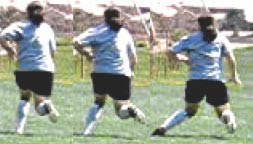You don’t run to get in shape, you get in shape so that you can run. Simply running every day will not improve your running ability. Cross training, improving muscle imbalances through corrective exercises, and strength training are all required in order to improve performance with running, and minimize the risk of overuse injuries.
You can take the same concept with any activity which requires repetitive motion, especially pitching. Simply throwing every day as hard as you can will only decrease performance and increase the likelihood of injury. There is a certain amount of core strength, rotator cuff stability, hip flexibility, and lower quarter stability that is required to optimize the movement of an overhead athlete. When an athlete has reached a certain level of strength and flexibility, I encourage using a TRX suspension strap to train these elements of pitching. My favorite TRX exercises for pitchers are listed below, but with a disclaimer: as healthcare professionals, we cannot simply prescribe exercises without a thorough examination of the athlete. These exercises should only be performed after an assessment and under the instruction of your healthcare specialist.
1) TRX Side Lunge

The stride phase of the pitch may be the most important phase of pitching. The stride length of a professional pitcher is approximately the length of the pitchers height, and the shoulder has to move towards end range of external rotation. Needless to say, in order to maintain proper mechanics the pitcher requires a certain amount of trunk control. Therefore, the TRX side lunge becomes a great exercise to work on adductor length of the stance leg (ensuring increased stride length) and trunk control during this motion.
2. TRX W Deltoid Fly

This exercise is named for the large deltoid muscle which assists with the abduction of the shoulder, but I like to use it to work the external rotators of the shoulder. This is also important for the stride phase of pitching, and requires a certain amount of instruction without the TRX before it can be done appropriately. After a pitcher learns appropriate joint centration of the glen0-humeral joint (to be discussed in a future blog) he can begin to train the rotator cuff to maintain the stability of the joint during pure external rotation. Again, all of this is being done while maintaining trunk control.
3. TRX T-Deltoid Fly

The cocking phase of the pitch requires scapula adduction and full external rotation of the gleno-humeral joint. At this phase of throwing, the middle trapezius operates at approximately 50% Maximal Voluntary Isometric Contraction (MVIC) and the Infraspinatus works at 74% MVIC. This exercise places works on these muscles to place the scapula and glen-humeral joint in the appropriate position for this phase of throwing.
4. TRX Lunge
Of particular note, at this time all exercises have focused on phases of pitching before the ball is released (showing the emphasis I place on the early phases of pitching). The most important component of the pitch after the ball is released is the follow through. Flexing through the hip and trunk can attenuate the force developed in prior phases from the shoulder. The TRX lunge can work on strengthening the gluteals and hinging from the hip to assist with this phase of throwing.
This form of training requires appropriate flexibility, strength, and supervision, but it can greatly improve your pitching mechanics. If you live in the Redlands area, a great spot for TRX training is at The Energy Lab. Check them out for their TRX classes and all fitness goals.
For rehabilitation, movement screenings, and to work towards your fitness goals, check out OMPT and email me at alan@optimalmovementpt.com


















